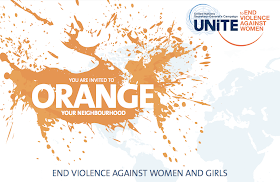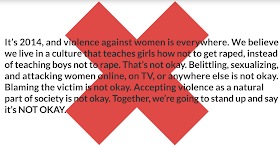We watch the news everyday only to hear the constant reporting about the violence against women on college campuses, in the military, from athletes, and by celebrities. It’s hard to believe that well into the twenty-first century this issue continues to plague our nation at such an alarming rate. Although we like to think of our society as more democratic toward the rights of women, we are not without fault.
Orange Your Neighborhood (
@SayNo_UNiTE) (#Orangeurworld) wants to raise awareness about this issue, not only in its 16-day campaign from November 25 to December 10,
Human Rights Day, but also to make every 25th of the month "
Orange Day."
Violence, victimization, and stereotypes about women fail to make it into daily classroom discussions any more than open conversations about
race. Violence against women is a global issue, and according to
UN Women, it is a global
pandemic.
Yet our education system, which is driven by pushing through curricula for high-stakes test results, often fails to shift, stop, and talk about current events and global issues. Learners need a forum to engage with difficult topics in a meaningful way, and we need to facilitate and not shy away from them. Global issues are not an elective.
It is not enough to say that we are a diverse nation, believe in civil rights, and promote equality for women. Title IX was passed 35 years ago, and the civil rights movement is over 50. Are we really that far ahead when we witness the daily barrage in the news? Education needs to go beyond the safe conversations under the guise of diversity. It’s not just equal pay for equal work, or the celebratory “Women’s History Month.” It’s about inclusion on multiple layers to talk about the tough topics, including violence against women. Breaking down the barriers for open and frank discussions is a necessity to educate global-minded citizens.
It is mind boggling that in this day and age, we still hear remarks about women dressing too revealingly and drinking too much as reasons for ending up as victims of sexual assaults. How disheartening that parental advice now includes "don’t put your glass down" when girls go off to college or go out with friends. It has nothing to do with sexy outfits and alcohol; it is about consent.
Some of these topics are not age appropriate for young learners, but empowering them to recognize stereotypes in the media is. For a host of resources, look no further than car and diet commercials, or Disney princesses of today vs. yesteryear. Children with a trained eye to spot bias in the media continue to apply their media literacy skills throughout life.
We need to do more. If we want girls and boys to grow up as respectful young women and men, we must find the time in the daily course of learning to educate them on issues. So,
Orange Your Classroom. There’s still time. Then continue the conversation on the 25th of every month. Violence against women does not stop, nor should our education about it.
For other educational resources, please see:












